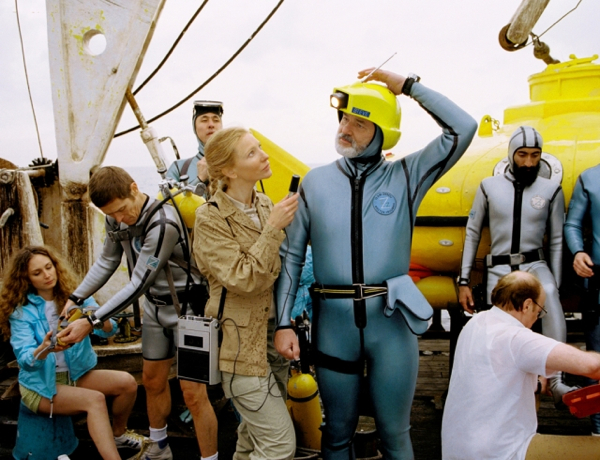Movie review by Greg Carlson
Wes Anderson’s fourth feature, “The Life Aquatic with Steve Zissou,” is mildly disappointing – if only because admirers have come to expect so much from the 35-year-old filmmaker. Lacking a significant measure of the heart and wit that cemented “Bottle Rocket,” “Rushmore,” and “The Royal Tenenbaums” in the pantheon of contemporary cinematic cool, “The Life Aquatic” stumbles when it should be gliding, and turns obvious whenever it gets the chance to be brilliant. The film certainly has its merits: meticulous production design, the director’s fascination with antiquated technologies, a three-legged dog – but it depends upon repeated viewings to unlock its deeper pleasures.
Like the Salinger-inspired NYC of “Tenenbaums,” the setting of “The Life Aqautic” nicks another of Anderson’s childhood passions: the adventure documentaries of Jacques Cousteau. Bill Murray’s Zissou is the fading paterfamilias of a misfit crew of nearly obsolete oceangoing filmmakers. Chugging along in a converted WWII-era sub-hunter called the Belafonte, Zissou deals with the recent death of his longtime collaborator by constantly smoking pot and withdrawing into a lethargic funk. The timely appearance of Air-Kentucky flier Ned Plimpton (Owen Wilson), who may or may not be Zissou’s son, offers the old salt an opportunity to demonstrate that he is not as washed up as everything thinks he is.
Anderson spends an inordinate amount of time setting up both the key themes and the narrative scaffolding, which will leave many viewers wondering what it is they are supposed to care about. Zissou’s apathy has the unfortunate side effect of occasionally spilling over to the viewers: he’s as idiosyncratic as any of Anderson’s previous creations, only much harder to like. Anderson has relied on questionable gender and racial stereotypes in the past, and Zissou’s homophobia remains troubling as a comic motif. Murray also holds back for so long, by the time we are supposed to feel sorry for him, it might be too late.
The movie’s biggest deficit is the mishandling of the brilliant supporting ensemble. Like “Tenenbaums,” “The Life Aquatic” boasts a director’s dream cast. Anjelica Huston, Cate Blanchett, Willem Dafoe, Jeff Goldblum, Bud Cort, and several others are denied the opportunity to register as fully formed characters. This is particularly vexing with Huston and Dafoe, who both do as much as they can with roles that remain woefully undernourished. Not even the movie’s euphonious musical palette can entirely compensate for the distance between the viewers and the characters, despite indelible inclusions like “Search and Destroy” and “30 Century Man.” In addition to another evanescent Mothersbaugh score, actor Seu Jorge beautifully reinterprets Bowie in Portuguese.
Anderson seems a bit young to be mining the self-reflexive territory of movies about movies (Fellini had twice as many under his belt before he went there), but presentational theatricality has always been a significant part of his world (glimpses of plays by Max Fischer and Margot Tenenbaum fire the imagination). One supposes it makes sense that Zissou should be a showman. Anderson’s own penchant for self-aware staging culminates early in a stunning tour of the Belafonte in full cross-section view – the effect is every bit as wondrous as the trippy tour of the details of the Tenenbaum mansion. Anderson’s contrived otherworldliness, which is always tempered by various interpretations of child-adult relationships, is a dreamy place to visit, even when it isn’t perfect.
